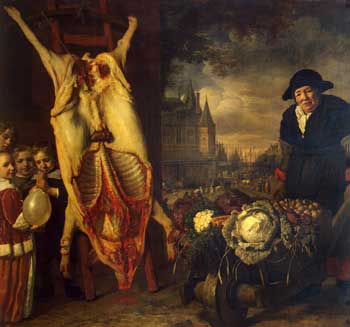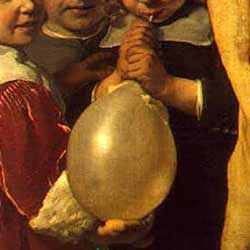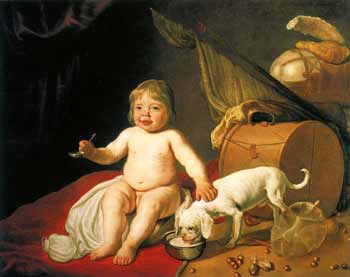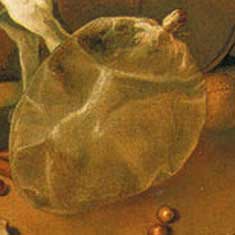Netherlands, (c.1613-1670)

-
Nieuwmarkt in Amsterdam
- [ View of the Newmarkt ]
- (1666), oil on canvas
- 79.1 x 86.6 in., (201 x 220 cm.)
- Hermitage Museum
-
Editor’s Note:
 This genre scene – View of the Nieuwmarkt, a square in the centre of Amsterdam combines still life, cityscape and figure piece. The composition shows an old woman holding a big wheelbarrow full of vegetables. On her left hangs the carcass of large slaughtered pig. Next to the pig are four children, one of whom inflates a pig’s bladder with a straw. In the background is a view on the Nieuwmarkt with the Sint Anthonis Waag. This work was probably made for van der Helst’s private use as it likely depicts the view from his house on the Nieuwmarkt.
This genre scene – View of the Nieuwmarkt, a square in the centre of Amsterdam combines still life, cityscape and figure piece. The composition shows an old woman holding a big wheelbarrow full of vegetables. On her left hangs the carcass of large slaughtered pig. Next to the pig are four children, one of whom inflates a pig’s bladder with a straw. In the background is a view on the Nieuwmarkt with the Sint Anthonis Waag. This work was probably made for van der Helst’s private use as it likely depicts the view from his house on the Nieuwmarkt.

-
Child with a Spoon
- [Allegory of Human Life]
- (1643), oil on canvas
- 39.3 x 51.1 in., (100 x 130 cm.)
- Private collection
-
Editor’s Note:
In his allegory of human existence Helst admonishes the viewer to be content with what life has to offer. The fleetingness of our existence on earth is symbolized by knuckle bones. The pig’s bladder echoes the another often used item – soap bubbles. Like blowing bubbles, the pig’s bladder recalls the brevity of human life, referring to the popular Latin saying `Homo bulla est’, man is a soap bubble.
Like blowing bubbles, the pig’s bladder recalls the brevity of human life, referring to the popular Latin saying `Homo bulla est’, man is a soap bubble.
The attributes of war like the military side drum are reminiscent of man’s futile struggle for military power. Holding a spoon the chubby child eats what he is given, just as the dog beside him. The message is clear: we must accept our fate.
About the Artist:
Bartholomeus van der Helst, Netherlands, (c.1613-1670) was a leading portrait painter of the Dutch Golden Age. His elegant portraits gained him the patronage of Amsterdam’s elite as well as the Stadtholder’s circle.
In addition to the portraits for which he is most famous, Helst also painted a genre, historical, biblical, mythological and allegorical scenes. In all these paintings, the portrait aspect is still important.
Helst lived and worked in Amsterdam where he was able to become the most popular portraitist in that city through his elegant and flattering portrayals in the style of Anthony van Dyck. His work was considered more immediately appealing than the dark, intense and introspective work during this later period of Rembrandt. He was also able to attract bourgeois patrons from other cities such as Rotterdam. [DES-08/18]
